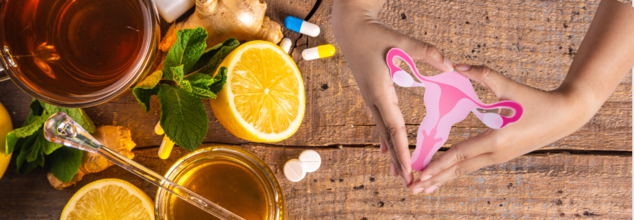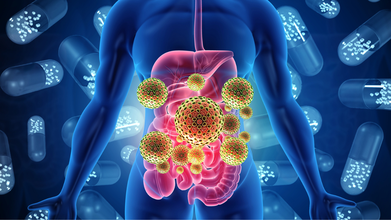- Health Conditions A-Z
- Health & Wellness
- Nutrition
- Fitness
- Health News
- Ayurveda
- Videos
- Medicine A-Z
- Parenting
Can A Herbal Concoction Clear Your Uterus Of 'Any Diseases'? Fact Check The Claim

Image Credit: Health and me
In the age of social media and quick fix health remedies, viral claims of herbal concoctions which promise to clean the uterus from diseases have grabbed much attention. One such viral claim has made its way through the Instagram reels suggesting that a simple herbal tea, made with red onion and shilajit capsules, removes uterine cysts, fibroids, and even controls the menstrual cycle. How accurate are these claims? Let's dig into the science of these claims, and sort out fact from fiction.
The Instagram reel claims to boil red onion in its skin and drink this concoction empty stomach or just before bed that will cleanse the uterus of cysts, fibroids, and so on. It is also promoting supplementary shilajit capsules. Some videos feature alternative medicine enthusiast Deepak Chopra who is preaching in this video. It promises women results right away-for example, how it can straighten out one's periods, get rid of reproductive health concerns, and other such benefits.
Medical experts refute all these claims vigorously. The uterus, they note, is a self-cleansing organ that doesn't need extraneous assistance to "detoxify" or "cleanse." Such claims lack scientific evidence, and in most cases, it's a matter of misinformation or even manipulated content, at times even generated with the help of AI.
It is important to understand why these claims fall short by grasping the nature of uterine cysts and fibroids.
Cysts
Fluid-filled sacs that develop in different areas, including the ovaries. Ovarian cysts are mainly benign and disappear over time without a need for surgical intervention.
Fibroids
These are abnormal growths found in the uterus. They appear in different sizes and cause the following symptoms; heavy bleeding, pelvic pain among others.
Both have to be diagnosed properly and receive adequate treatment. Medication or surgical methods may occasionally be necessary. Herbal teas and remedies, though helpful for general well-being, do not have the capacity to dissolve cysts or fibroids.
Lack of evidence and adequacy on the use of herbal preparations to the study done on uterine fibroids was concluded. That is, more studies of higher quality are needed to fully understand if herbal remedies can possibly contribute any positive effects on the health of the uterus.
Some medicinal plants and herbs are actually capable of exhibiting anti-inflammatory and antioxidant activities; however, their contribution toward addressing issues like those in fibroids and cysts had not yet been proven.
Foods That Can Promote Uterine Health
Although no food or beverage can prevent, eradicate, or kill fibroids or cysts, a healthy diet can be a useful tool in the reduction of possible risk factors and control of symptoms. Foods high in the essential nutrients, antioxidants, and vitamins can have a general benefit for the reproductive organs.
Fruits and Vegetables: Produce such as apples, broccoli, cabbage, tomatoes, and citrus fruits (oranges, lemons, grapefruit) are rich in antioxidants and may reduce the risk of developing fibroids.
Calcium-Rich Foods: Dairy products such as milk, yogurt, and fortified alternatives (soy, almond, or oat milk) are good sources of calcium and vitamin D, which studies suggest may reduce the risk of fibroids.
Vitamin D-Containing Foods: Some of these include light tuna, salmon, and rainbow trout, which provide immune health as well as balance to hormones.
Herbs and Spices for Uterus- Related Ailments
Even though red onion tea and shilajit cannot cleanse the uterus, a few herbs and spices may ease symptoms of disorders such as endometriosis or premenstrual syndrome (PMS).
1. Curcumin: This is a compound found in turmeric that has shown anti-inflammatory effects and may be able to suppress the production of estradiol, a hormone associated with endometriosis.
2. Chamomile: Chamomile tea has been used to alleviate PMS symptoms, and its active compound, chrysin, has been reported to inhibit the growth of endometrial cells.
3. Essential Oils: A combination of cinnamon, clove, rose, and lavender oils applied during aromatherapy massage reduces menstrual pain and bleeding.
4. Ashwagandha: This is an adaptogenic herb used to reduce stress, which can indirectly benefit women with hormonal imbalances or chronic conditions like endometriosis.
While the allure of natural remedies is strong, especially when presented as quick and easy solutions, it’s essential to rely on evidence-based healthcare. Self-diagnosing and experimenting with unproven remedies can delay necessary medical treatment and lead to complications.
Consulting a healthcare provider is critical for accurate diagnosis and tailored treatment plans. Doctors can also provide guidance on incorporating safe and effective complementary therapies into your routine.
There is no scientific basis to support the fact that a simple herbal concoction can cleanse the uterus of "any disease," which misleads the individuals to follow some ineffective remedies. The uterus does not require any kind of external "cleansing" for it to work at its best, and cysts and fibroids are usually treated by proper medical care.
Generally speaking, a proper diet with essential fruits, vegetables, and supplements can help develop overall reproductive well-being, however, it shall not replace other medical treatments and interventions. Also, herbs and plants such as chamomile, turmeric, and ashwagandha have been confirmed to be efficient in treating most related conditions.
Always be up to date, follow trusted health care professionals, and beware of fads that promise miraculous improvements in health with less scientific proof. Your health deserves nothing less.
Herbal preparations for uterine fibroids. Cochrane Database Syst Rev. 2009
Curcumin inhibits endometriosis endometrial cells by reducing estradiol production. ran J Reprod Med. 2013
Comparison of the effects of Matricaria chamomila (Chamomile) extract and mefenamic acid on the intensity of premenstrual syndrome. Complement Ther Clin Pract. 2014
The effect of aromatherapy abdominal massage on alleviating menstrual pain in nursing students: a prospective randomized cross-over study. Evid Based Complement Alternat Med. 2013
A Systematic Review of Human Trial Results Reported for the Ayurvedic Herb Ashwagandha. The Journal of Alternative and Complementary Medicine. 2014
Prolactin and cortisol levels in women with endometriosis. Braz J Med Biol Res. 2006
At 66, Emma Thompson Lost 8kg by Ditching Diet Culture; Why Say This Approach Works

Credits: Wikimedia Commons
Dame Emma Thompson believes that eating well is never about punishment, food guilt, or obsessively tracking every bite. So what did she do to lose 8 kgs? She ditched diet.
Instead, she follows what she openly calls an “anti-diet” approach. It is not about restriction but awareness. She pays attention to what she eats, fuels her body properly, and still makes space for the foods she genuinely enjoys. That balance is exactly why the method has worked for her long term.
A couple of years ago, the 66-year-old actor and screenwriter lost around 8kg without falling into the trap of rigid rules or trendy superfoods. Rather than cutting entire food groups, Emma focused on consistency, structure, and realism. The result was not just weight loss, but better energy and a healthier relationship with food.
What the Anti-Diet Plan Looks Like in Real Life
Emma worked with Louise Parker, a trainer and nutrition coach known for promoting sustainable habits over quick fixes. The plan itself was calorie-controlled but far from extreme. It included three regular meals a day, each centered on protein to support muscle and keep hunger steady. These meals were paired with slow-digesting carbohydrates such as whole grains, vegetables, and fruit, along with healthy fats for satiety. Two snacks were also built into the day, removing the feeling of deprivation that often leads to overeating later.
The idea was not perfection, but rhythm. Eating regularly helps stabilise blood sugar, reduces cravings, and prevents the binge-restrict cycle that derails many diets. This structure alone can make a significant difference for people who have spent years jumping between extremes.
Why Enjoying ‘Forbidden’ Foods Matters
One of the most refreshing aspects of this approach is that no food is completely off-limits. Emma has spoken openly about enjoying things like cheese, bacon, and even wine occasionally. This is not indulgence for the sake of it. It is a strategic choice.
When people label foods as “bad,” they often end up craving them more. Allowing flexibility removes that psychological pressure. Interestingly, many foods marketed as healthy can be more calorie-dense and less satisfying than traditional options. By eating foods she actually enjoys, Emma avoided the constant feeling of missing out, making the plan easier to maintain over time.
A Rejection of Crash Diet Culture
Emma’s resistance to dieting is deeply personal. Earlier in her career, she tried crash diets and paid the price. She has spoken candidly about how dieting disrupted her metabolism and negatively affected her mental health. Like many people, she was sold the promise of quick results, only to experience long-term consequences.
This honesty highlights an important truth. Extreme restriction may deliver short-term weight loss, but it often damages the body’s ability to regulate hunger and energy. It also fuels a harmful cycle of guilt and rebound weight gain.
The Role of Exercise and Lifestyle Habits
Food was only one part of the equation. Emma also followed an intense fitness routine that included resistance training and ballet-inspired movement. Strength training plays a crucial role in preserving muscle mass, improving metabolism, and supporting long-term weight management. Alongside exercise, sleep, recovery, and mental wellbeing were treated as non-negotiables rather than afterthoughts.
Why This Approach Is Easier to Stick To
Behavioral science consistently shows that
sustainable change comes from habits that fit into real life. Flexible eating patterns that allow enjoyment, regular meals, and adequate nourishment reduce reliance on willpower. When people stop viewing food as the enemy, consistency becomes far more achievable.
Emma Thompson’s “anti-diet” approach works because it respects both biology and psychology. It replaces punishment with practicality, and restriction with balance. That combination is what turns healthy eating from a temporary phase into a lifestyle that actually lasts.
Christmas Delights Mince Pies Urgently Recalled In UK, Know Why

Credits: Canva
Mince pies, a Christmas delight, has been recalled just a few hours before Christmas in UK, over dangerous 'health risks'. The Food Standards Agency (FSA) warned consumers that there could be certain allergies and intolerances that could occur.
Why Are Mince Pies Recalled?
Shallow Brandy Mince Pies by the Bakewell baker have been recalled because it contains milk, "which is not mentioned on the label", noted the FSA notice, issued on December 23.
"The product is a health risk for anyone with an allergy or intolerance to milk or milk constituents," read the FSA notice.
The affected batch include six packs with the following best before dates: 2 February 2026, 3 February 2026, 4 February 2026, and 5 February 2026.
What Does The FSA Notice Say?
Why is the product being recalled?
We have identified that it has been labels incorrectly. Allergen missing. Product contains
milk not declared labels an ingredient has. This may pose a risk to customers.
What should customers do?
Please call the office.
• If you have purchased this product, please do not consume it.
• Return it to the store where it was bought for a full refund. No receipt is required.
FSA issued a "do not consume" notice to warn customer who could be affected.
What Happens When Lactose Intolerant People Consume Milk Or Milk Based Products?
When lactose intolerant people consume milk or milk-based products their bodies cannot properly digest the lactose sugar, leading to uncomfortable digestive symptoms like gas, bloating, cramps, abdominal pain, rumbling sounds, nausea, and diarrhea, usually within 30 minutes to 2 hours, because the undigested lactose ferments in the gut. Severity varies by individual, but it's generally a harmless condition, manageable by limiting dairy or using lactase supplements, and is different from a milk allergy.
Common Symptoms
- Gas & Bloating: Bacteria in the large intestine ferment the lactose, producing gas and causing the gut to stretch.
- Cramps & Pain: Fermentation creates acids and gases, leading to pain around the navel and lower abdomen.
- Diarrhea: Excess water and gas in the colon can result in loose stools.
- Nausea & Vomiting: Some people experience nausea or may even vomit.
- Stomach Noises: You might hear rumbling or "growling" sounds
However, not everyone is lactose intolerant, some may have an allergy from milk, which could lead to different allergy symptoms, which include:
- Hives
- Skin rash
- Stomach upset
- Runny Nose
In fact, severe symptoms could also lead to wheezing, throat swelling, difficulty breathing, vomiting, anaphylaxis.
Are There Any Alternatives To Mince Pies?
There are mince pies available without milk or using any dairy. These dairy-free pastry, which are often made with vegetable oils or vegan butter substitute plant-based milk for brushing, or skipping the milk wash entirely. Traditional pie crusts use ice water as the liquid, so replacing milk is easier.
Always pay attention to be label to know if it contains any ingredient you may be allergic to.
Why is Butyrate Called Gut Petrol, Are You Low On It? Here's How Changing Your Diet Can Help

Credits: iStock
Your gut's petrol maybe running low and it is causing you all sorts of gut issues. But, what does it really mean?
Bloating that doesn’t settle, gas that feels unpredictable, sluggish digestion, and a constant sense that your gut just isn’t cooperating anymore. All of these complaints are becoming increasingly common, especially in urban India. While many people blame stress or food intolerances, experts say the issue may lie deeper, at the level of the gut microbiome. One key reason: falling levels of butyrate, a small but powerful compound essential for gut health.
Often described as the gut’s “petrol,” butyrate plays a critical role in keeping the digestive system resilient and balanced.
What Is Butyrate and Why Does It Matter?
Butyrate is a short-chain fatty acid (SCFA) produced when beneficial gut bacteria ferment dietary fiber. Think of it as the primary fuel source for the cells lining the colon. When enough butyrate is present, the gut lining stays strong, inflammation remains under control, and digestion functions smoothly.
When levels drop, the gut barrier weakens. This can lead to inflammation, slower digestion, immune imbalance, and even disruptions in metabolism and mood. In simple terms, low butyrate means the gut struggles to repair and protect itself.
A Silent Deficiency on the Rise
Recent gut microbiome analyses suggest that butyrate levels are declining sharply, particularly among adults living in metro cities. The drop isn’t limited to older age groups, even people in their 20s and 30s are showing early signs of imbalance.
While other SCFAs like propionate and acetate may remain relatively stable, butyrate appears to be the first to fall. This imbalance is increasingly being linked to rising cases of irritable bowel symptoms, unexplained digestive discomfort, and metabolic issues, even when routine tests appear normal.
What Low Butyrate Says About Your Gut
Low butyrate usually signals one of two problems, or both. Either the butyrate-producing bacteria are disappearing, or the diet lacks the fibers those bacteria depend on. Many people believe they eat “healthy,” yet still miss out on fiber diversity.
Without adequate fuel, beneficial bacteria struggle to survive. As a result, the gut ecosystem shifts, leading to symptoms such as bloating, cramps, urgency, alternating constipation and loose stools, fatigue, brain fog, and sugar cravings. These issues often go undetected because structural tests show no obvious damage.
How Modern Diets Are Fueling the Problem
Traditional Indian diets once provided a wide range of fibers through millets, dals, vegetables, fermented foods, and seasonal produce. Over time, these have been replaced by ultra-processed foods that are low in fiber and high in sugar and refined carbohydrates.
Add irregular meal timings, chronic stress, poor sleep, frequent antibiotic or painkiller use, and environmental pollution, and the gut microbiome takes a hit. The bacteria that produce butyrate simply fade away, much like shutting down a factory that no longer receives raw materials.
Rebuilding Butyrate Naturally
Restoring butyrate isn’t about quick fixes. Supplements may provide temporary relief, but they don’t rebuild the ecosystem. The foundation is dietary diversity.
Foods that help feed butyrate-producing bacteria include millets, legumes, whole grains, fruits, vegetables, seeds, and resistant starches. Everyday foods such as bananas, onions, garlic, oats, and cooked-and-cooled rice act as natural prebiotics. Fermented foods like curd and buttermilk also support microbial balance.
With consistent changes, the gut can slowly restart its butyrate production, though meaningful recovery may take several months.
Why Fiber Awareness Matters More Than Ever
Low butyrate isn’t just a digestive issue. It reflects how modern lifestyles are reshaping gut health at a population level. Improving fiber diversity could strengthen immunity, metabolism, and long-term health more effectively than treating symptoms later.
In many ways, restoring butyrate means returning to simpler, whole-food eating habits — and giving the gut the fuel it was designed to run on.
© 2024 Bennett, Coleman & Company Limited

